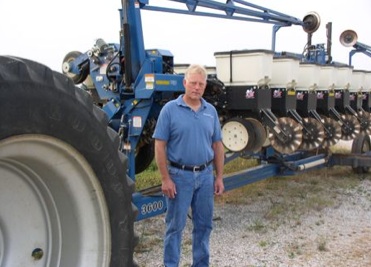|
|
Hardin County Kentucky farmer Bob Wade Jr. has always been a good conservation steward of the land. He says, “my dad was conservation minded and he passed those values on to me.”
When he purchased a 273 acre farm in 1986, he incorporated his father’s philosophy of good land stewardship. He never thought of using tillage implements on his farm.
Now, Bob Wade Jr. farms nearly 3,000 acres of continuously no-tilled corn and soybeans. The dominant soil is Pembroke silt loam (a fine-silty, mixed, active, mesic, mollic paleudalf), on slopes of 2 to 6 percent. Crops grown are no-tilled into the previous year’s residues resulting in minimal erosion rates.
Previously, this 273 acre farm had been conventional tilled. It makes Wade feel very satisfied to see the land improve because of his continuous no-tillage practices. He can see a big difference in the soil quality of his land since it was purchased 21 years ago.
The concept of soil quality is very important to Wade. He says, “one of the biggest benefits of implementing a no-till strategy on his farm has been the increase in macropores created by earthworms.”
Earthworms create macropores that increase soil tilth as well as soil water holding capacity. Wade knows the value of earthworms and strives to increase earthworm populations on his land.
To implement a no-till strategy, landowners must change the way they think about farming. It truly is a paradigm change from the previous plow, disk, and plant method to a continuous no-till method where all crops, including sod, are no-tilled or drilled into a previous year’s crop residue or cover crop.
Basically, landowners change from managing for a soil loss tolerance level to managing for increased soil carbon and organic matter, carbon sequestration. In other words manage for soil quality.
Implementing a no-till strategy involves more than just using a no-till planter. It involves implementing a complete no-till system were no surface tillage is performed during any planting operation and where some type of ground cover remains on the soil surface at all times.
Wade has been building soil quality on his land for the past 21 years and would not want to perform any tillage operations because it would set back the numerous soil quality gains made during that time.
Even after 21 years of implementing a continuous no-tillage system, it only takes one plowing, disking, or chisel plowing to deplete the numerous soil quality gains made over this 21 year period.
No-tillage systems increase organic matter on the soil and roots in the soil. Tillage systems increases decomposition of organic matter through oxidation, resulting in a decrease of organic matter from the soil and the release of soil carbon into the atmosphere as carbon dioxide.
This not only depletes the soil of a vital necessary component, it also damages the environment by releasing carbon dioxide into the air where it possibly enhances global warming.
Tillage decreases; soil structure, soil aggregate size and strength, water holding capacity, cation exchange capacity, and earthworms, while increasing soil bulk density and erosion.
All these attributes of tillage are detrimental to crop production and soil quality. The bottom line is a no-till strategy increases soil quality while tillage decreases soil quality.
Wade is implementing one of the key components of the no-tillage system, that being managing his organic matter. Wade says, “organic matter levels in my soil have improved over the years and yields have steadily increased.”
Organic matter can hold up to 90% of its weight as water thereby increasing water holding capacity and soil infiltration.
Other benefits of Wade’s no-till system are: less equipment, lower equipment cost, lower labor cost, lower fuel cost, and time savings. All this contributes to a higher net profit and more take home income.
You may wonder what challenges Wade has faced while implementing a no-till strategy on his farm?
One challenge he faces is isolated areas of shallow root growth due to compaction on some fields. Wade overcomes this by testing his soil for compaction to identify the compacted areas.
After Wade has identified and located the isolated compacted areas, he uses a narrow straight shank ripper to break up the compaction within those areas.
The narrow straight shank ripper breaks up compaction with minimal soil disturbance at the surface. This allows him to maintain the soil quality benefits he has gained from years of continual no-tillage.

 FIGHTING COMPACTION. Bob Wade Jr. says one challenge he faces is isolated areas of shallow root growth due to compaction on some fields. He overcomes this by testing his soil for compaction to identify the compacted areas. (NRCS Photo)
FIGHTING COMPACTION. Bob Wade Jr. says one challenge he faces is isolated areas of shallow root growth due to compaction on some fields. He overcomes this by testing his soil for compaction to identify the compacted areas. (NRCS Photo)




Post a comment
Report Abusive Comment